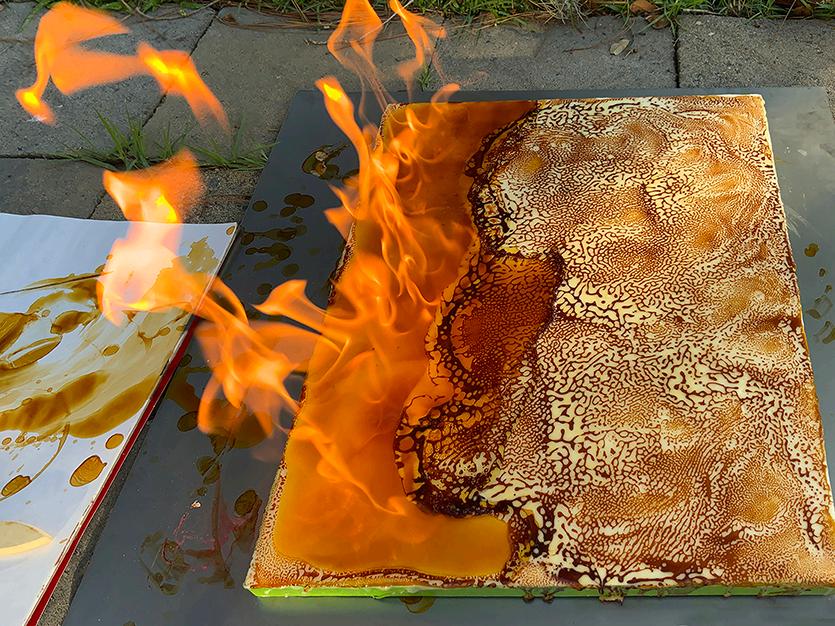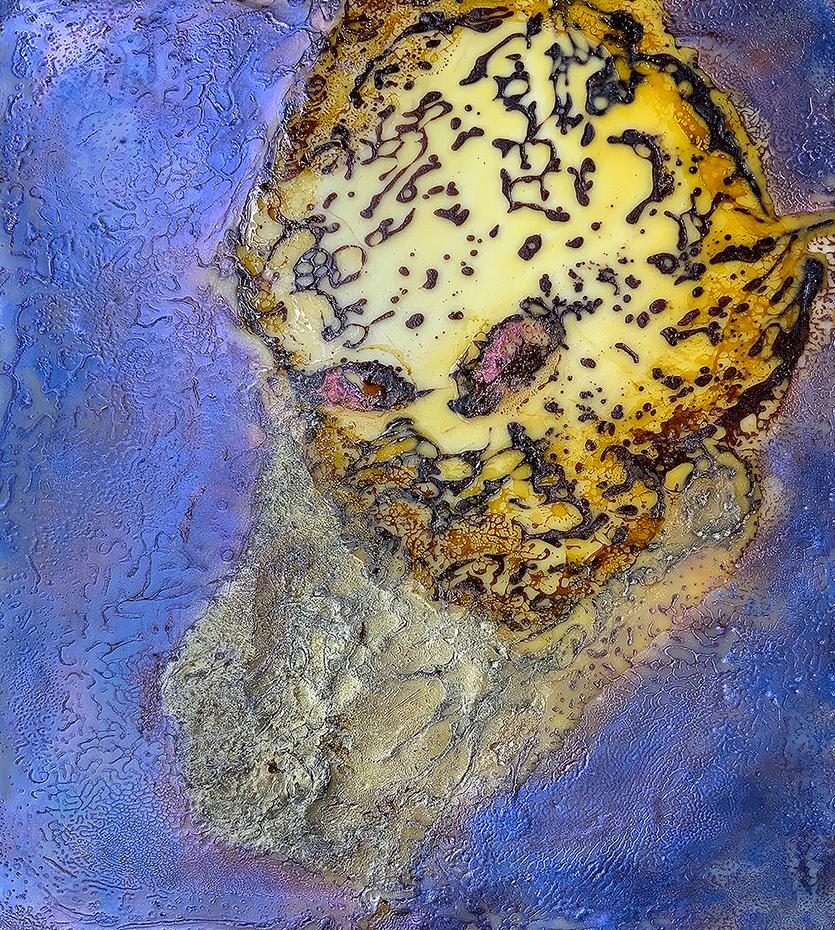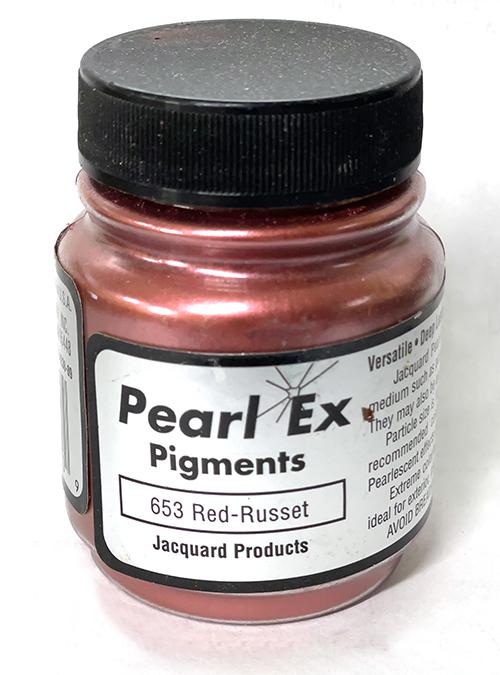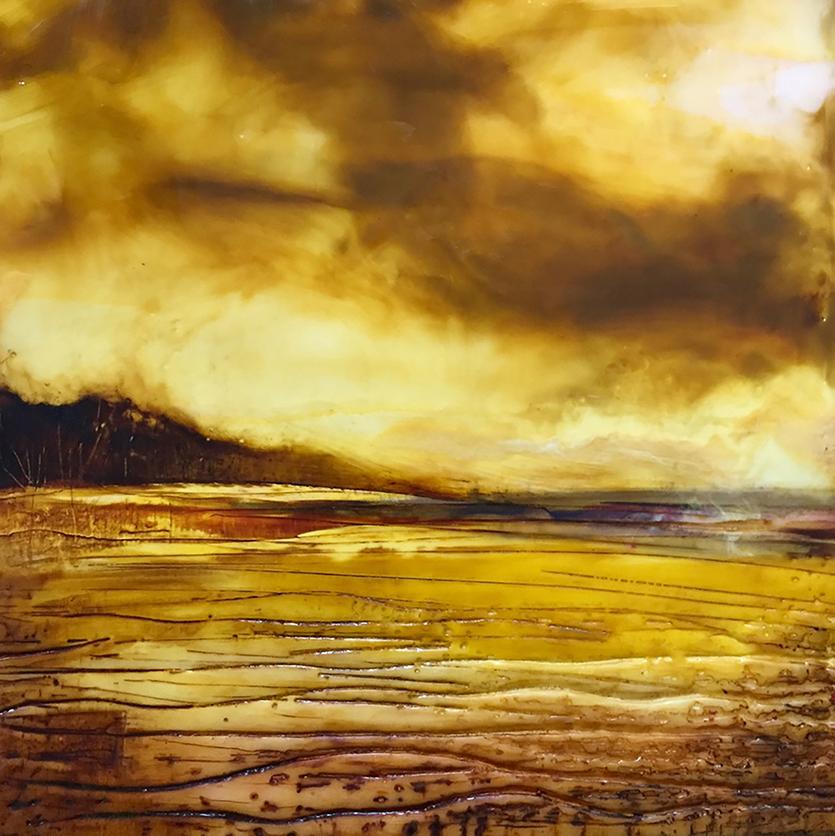
6 minute read
Encaustic Wet Shellac Burns
Paul Kline
I was invited to participate in a 2021 Encaustic Exhibition at Texas A&M University, and the curator specifically requested an encaustic wet shellac burn. Years ago, I worked almost solely with this technique, but no longer had any works. I decide it was time to pull out my materials and create a new work for the exhibition.
For brevity, I have listed the steps I went through to create the painting, Genie.
I find that the best supports for shellac burns are Ampersand Encausticbords. On a 16” X 20” cradled panel, I applied 8 layers of encaustic medium, fusing each layer as I progressed. I wasn’t concerned about the medium being even and level since the shellac will burn into the surface. A slightly uneven surface sometime provides good webbing.

I recommend that wet shellac burns be done outside in an open area, where there is little chance of a breeze or other wind movements. You want to avoid any air movement that might turn the flames toward you or create another chance of burning something else.
It is possible to do burns indoors, where there is proper ventilation and the surfaces are nonflammable such as metal, concrete, or fire-retardant materials.
On our patio, I placed the prepared panel on a thin sheet of aluminum. I laid out all the materials I needed for the wet shellac burn. What are not visible are my fire extinguisher and respirator.
Materials List:
1 – 16” X 20” Ampersand Encausticbord 1 – 30” X 30” aluminum sheet Can of Amber Shellac Screwdriver Encaustic medium Paper towels and rags Aluminum sheet Lighter Fire extinguisher Mica powders Respirator and/or protective glasses


I prefer pouring the shellac directly from the can onto the prepared panel, usually covering the board one section at a time.
You can also apply the shellac with a brush or by dabbing shellac onto the panel with a rag or paper towels or a combination of these.
For a wet shellac burn, I ignite the shellac almost immediately after pouring it on the painting surface.

Wet shellac burns can be difcult to control. I generally allow the shellac to burn out on its own, which creates random patterns or cells in the melted encaustic medium. If there are small pockets of fire near the end of the burn, I simply blow them out.
I worked in sections and saw an image begin to form in the patterning. I admit that I do not always achieve an image efect with just one burn. Often, I need to repeat burns on top of tacky burns, or repeatedly go over burned areas with a torch to create an image or area of interest.
A detail view of this wet shellac burn is also featured on the front cover.


Final burn for Genie

Genie Encaustic, wet shellac, and mica powders on cradled board 20 x 16 in
If you want to add color, there are diferent materials to experiment with – dry pigments, alcohol inks, graphite, and my favorite, mica powders.
Mica powders are a fine powder, most often used in glass blowing and in cosmetic eyeshadows. Many colors have a strong reflective quality that can shimmer under bright lights.
The powder can be tricky to work with since it is so fine. A wind, even a sneeze, can blow the powder away.
As I placed the powder on the burned panel, I used a heat gun to fuse it into the shellac and encaustic medium.
When I am satisfied that a painting is finished, I use a soft sable brush to lightly dust the surface to remove any loose powder.
Next, I allow the painting to lie flat for 2 to 3 days until the surface is set and dry to the touch. After 2 or 3 weeks of drying, the painting is ready for framing.
What I love most about wet shellac burns is the lack of control and the random patterning that is created. With this work, I wanted to suggest a Genie coming out of its bottle in a golden mist.

A Brief Introduction to Shellac
Commercially, there are two types of shellac one can buy: clear shellac and amber shellac, which is darker in tone. And there are 4 techniques that can be used for shellac burns: Wet, Tacky, Dry, and Combination.
Wet Shellac Burn
For a wet shellac burn, one lights the shellac before there is any chance of the shellac setting up. When lighted, there will be a swoosh of flames perhaps 2 or 3 feet tall that melts the shellac into the encaustic medium, creating random patterns or cells as the flames subside.
Tacky Shellac Burn
With a tacky shellac burn, allow the shellac to dry partially becoming tacky to the touch. With this burn, it is probably not possible for flames to appear. Instead, a hot flame such as torch will melt the shellac into the encaustic medium, allowing for patterning to develop, which is less intense than a wet burn.
Dry Shellac Burn
For a dry shellac burn, the shellac applied to the painting surface sets and is no longer tacky to the touch. Again, a torch is used to create smaller, lighter patterns on the painting surface. The patterns created will be less random, and this technique is often used when one wants to create a light, soft pattern efect, e.g., creating the efect of floating clouds.
Combination Burn
Combining two or more of the burns listed above.

Empyrean Isle Encaustic, wet shellac, and mica powders on cradled board 24 x 24 in

The Song of God Encaustic, wet shellac, and mica powders on cradled board 24 x 24 in
About the Author Paul Kline is a non-objective abstract painter. He started painting and drawing at the age of 5, and he comes from an artistic family. As a young child, he only wanted to become an artist.
In 1975, Paul Kline earned a master’s degree in art history and studio art, having studied with Emery Bopp who was a student of Josef Albers at Yale University. Throughout the ‘70s and 80s, he taught painting and art history in California, exhibited his work extensively, and juried many exhibitions in the Santa Barbara area. From 1980 – 1983, he was a Fulbright Scholar to Poland, where he taught and completed research for his doctoral degree in art history. In 2000, Paul relocated to Manhattan, where he was the Executive Assistant to Thomas Krens at the Guggenheim Museum.
Paul has taught studio arts and art history for more than 40 years. A major component when he paints is the physicality and action of painting that allows him to be expressive. Paul finds a painting develops, much like a dance, from one action to the next and the next and so on.
Paul is represented by Design Art Concepts in Miami, FL, and by the Cortile Gallery in Provincetown, MA. He and his spouse have retired to Savannah, GA, with their standard poodle and tabby cat.
You can view Paul’s work at www.paulklineart.com www.faceartnet.com/253-paul-kline www.saatchiart.com/account/artworks/889098 www.singulart.com/en/artist/paul-kline-24879?/campaign_id=1044 www.instagram.com/paulklineart You can view Texas A&M University’s Wax Applications at pride.tamuc.edu/art/events/wax-applications/ youtu.be/htlbYZUptLM










